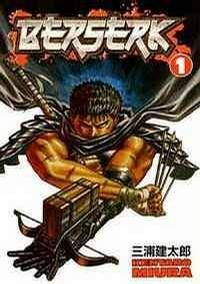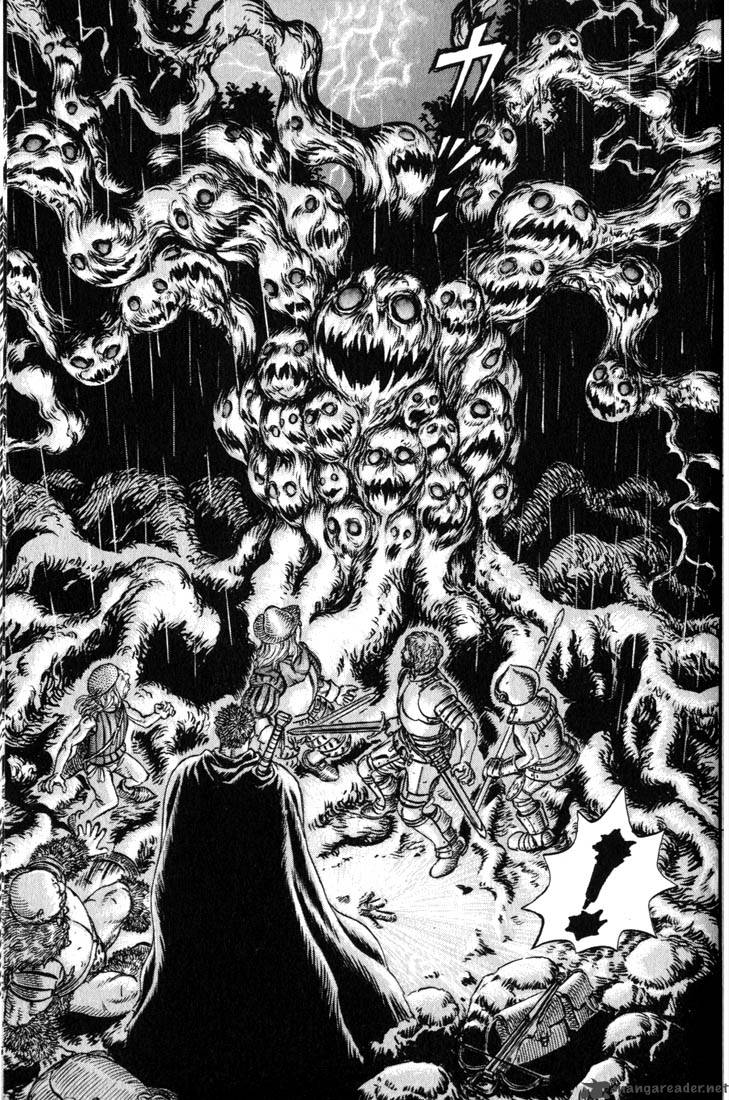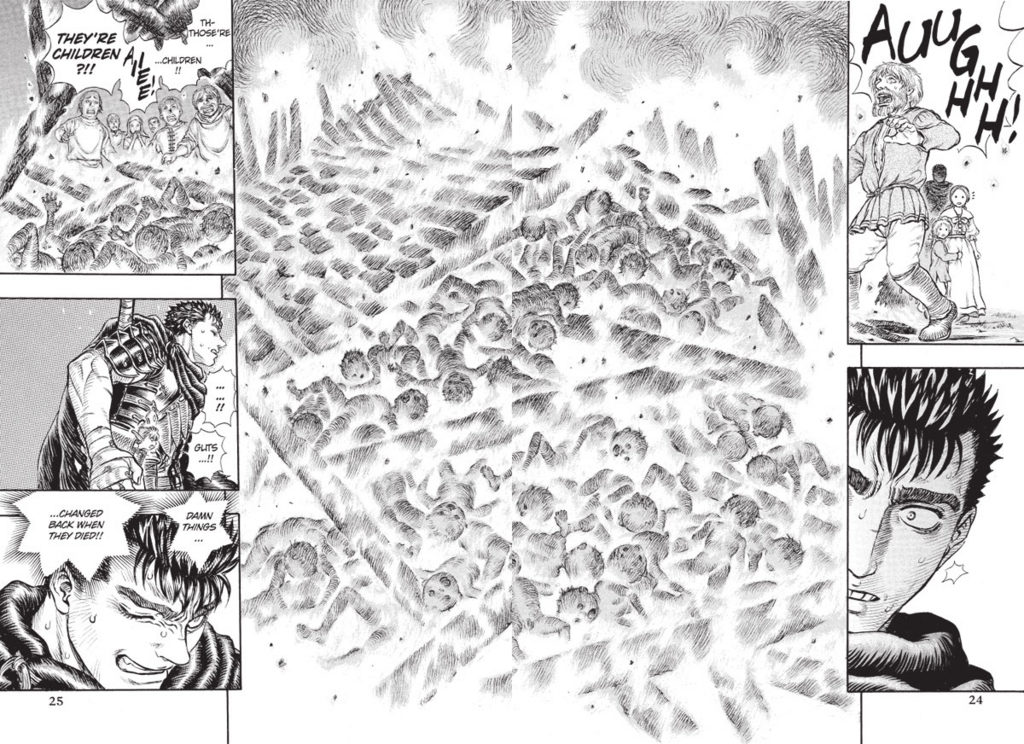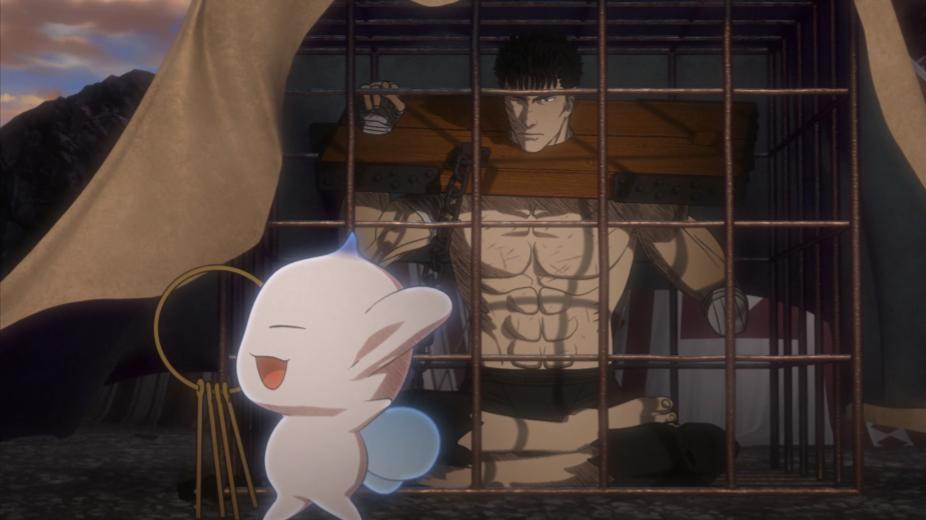If you’re like me, a diehard fan of Kentauro Miura’s long-running and hopelessly delayed manga series, Berserk, then I guess we’re in the same boat. Pun intended. Over two years ago, there was nary a thought about anything remotely having to do with Berserk’s post-Golden Age arc ever seeing the anime-light of day. Then, we were treated to the polarizing 1st season of the cell-shaded anime, but with the first season now behind us and with the 2nd season underway, let’s take some time to sit back and reflect on the new series we got. There’s plenty to break down: the interesting direction, the animation, music, but I wanted to explore the choice of the first season starting with the Conviction arc instead of the “Black Swordsman” arc, as well as some comparisons between the manga and anime, and how the anime could have been improved had they not cut out so much.
I mostly wanted to tackle the first couple episodes, but specifically the first, because I find the introduction both engaging and questionable. I wanted to highlight many of the differences between the manga and the anime here because after the first two episodes, both the manga and anime begin to parallel. However, it’s my belief that the structure of our introduction to Guts in the new anime reflects poorly on the story Miura was telling in the manga. That isn’t to say the anime isn’t doing a great job. Rather, much like the way Netflix’s Iron Fist was introduced, there’s a lot of pieces missing to Berserk’s complex puzzle of a story.
For those not intimately familiar with the series, Berserk started off as a manga drawn and written by creator Kentauro Miura. First published in Japanese seinen magazine Young Animal in August 1989, the series revolves around a young mercenary named Guts, born and raised on the battlefield in an all too literal sense. Guts lives a rather tragic life, learning to use a sword twice his size just to survive, a rape survivor, raised by a resentful, abusive foster father who blames him for everything bad in his life; God really throws him one nasty curveball. Or as this series explores, whatever the fuck God is, he’s no better than the God Hand. The series has suffered a number of delays since it was first published. Fans, the really devout ones, have waited anywhere between months and years just to get a taste of the next issue. They weathered the hurricane just to get a glimpse of the rainbow, kinda like that Katy Perry song. Well, I’m sorry, this is Berserk. There are no rainbows or fireworks. Instead, there are only blood spatters and explosions, and lots of rage; rage caused mostly by extensive delays.
So let’s start with what was omitted from the anime; the Lost Children story arc. In the manga Lost Children serves to give readers a chance to reacquaint themselves with the Guts they were originally introduced to – the one we all know and love – The Black Swordsman. It also serves to familiarize readers with the world they first started with; one filled with demons, monsters, and a whole lot of fuckery; I guess the fuckery never truly went away, but it definitely revs up. In this arc, Guts was cold, dirty, and easily unhinged when his life was on the line. In the anime? Well, he doesn’t seem to embody any of this at all. He comes off as introverted, and sort of a loner with a “devil may care” attitude and a bottomless well of inner strength.
In the beginning of the anime, we get an amalgamation of events from the Black Swordsman and Lost Children arcs, and see them fused into the Binding Chain arc. It all begins with a stagecoach, a missionary, and a young girl who offer to give Guts a lift and a place to sleep. While this scene provides a bit of decent info about Guts, it doesn’t really characterize him very well. At the same point in the manga, Guts can barely stand having Puck around – think Navi but male and naked – to the point of murderous irritation, and there’s no way he’d endanger an entire caravan for the convenience of sleep, and in fact, that was pretty well established in the Black Swordsman arc. During “Lost Children,” he makes this statement evidently clear that to accompany him is to live between both worlds; Earth and Hell.
There’s even a pretty heartless scene where he’s a complete dick to some villagers he comes across, especially the ones who’ve lost children to this crazy loli-moth demon named Rosine. Eventually he tangos with some evil moth fairies hell-bent on killing the villagers, kills a bunch of them, almost dies, kills some more, and then gets cast out by the villagers for his trouble; real hospitable folk. Guts not only accepts this type of fallout, but embraces it. It’s like fuel for his rage so that it never tempers, and later we start to see it manifest into a dark red-eyed beast. As an avid reader, it’s equal parts heart-wrenching and compelling.
Which brings me to my first point; in the manga, Guts comes across a young girl named Jill, a girl he rescues from a troupe of bandits. The bandits however, don’t get eaten by the evil tree like in the anime. The entire scenario begins as a frightful story told around a campfire of bandits and Jill -who they plan to sell as a sex slave – and in the story, tree in questions was once a sacrificial site where heretics would ritualistic murders and suicide. When Guts intervenes, his mark reacts, causing the tree to animate into a bloodthirsty monster. Guts eventually blows it up with his arm cannon, but it plays out like a cunning ploy to lure the tree into getting Guts’ body closer to its mouth. This shows Guts having a degree of tact and critical thinking masked as recklessness, and you know, things you’d probably develop after years of mercenary work and demon hunting. The guy puts the Winchesters to shame, but I digress. Needless to say, Guts destroys the tree.
In the anime, Guts’ characterization is somewhat watered down. He’s down-trodden, almost sluggish, and he’s completely zoned out. He ends up endangering the caravan, gets a young girl, Collette – a sit-in for Jill – killed in the chaos, and once she reanimates and stabs him, he hesitates, which is something he’s never done in previous anime or manga. Mind you, him getting stabbed here nearly incapacitates him for the duration of the episode, yet completely fine after he’s been captured. Mind you, he suffers even more injuries between Colette and the time of his capture. The beginning couple episodes are highly inconsistent. One scene he’s Mr. Glass, and the next he’s Wolverine. It’s frustrating to see because I understand the message being conveyed, but it’s completely dishonest to Guts’ characterization. Guts readily defeats the demon army, cuts Collette in half, vomits – I’ll get to that – and continues to butcher more demons. From hesitating to unwavering, the Guts we’re initially introduced to feels too inconsistent. The tree fight kind of parallels with the manga version except for the fact that everything I mentioned about Guts being crafty and sneaky during this fight is completely non-existent in the anime.
Guts gets severely beaten by the demon tree, and seems to rely more on luck and deus ex machina masked as sheer force of will once he blows it to hell with his arm cannon. Then, he unleashes a wind scar of Inuyasha proportions, obliterating the tree completely. If that wasn’t bad, the only reason he was able to do any of that was because he was super triggered by a dead Colette dangling above the Tree’s mouth. He gets flashbacks of Casca getting raped by Griffith, and only then does his life’s mission begin to matter. On my first viewing I didn’t think much of it, because I was so hyped that we had a new Berserk title, but when I revisited it in order to write this recap, I got so many headaches. Initially I just wanted to absorb the fact we were all finally moving forward with a new series. I hate to be that guy that wants everything done perfectly panel-for-panel, but the rest of the anime after this is literally panel-for-panel until the very end of the season and it’s so horrifically lovely.
So let’s move on to the vomit scene. Is it me, or did the scene where Guts vomiting after cutting Colette down seem very rushed and random? I get it, though. The anime aims to humanize him as he cuts down a small child, because it matters that he doesn’t do it carelessly. In some twisted, abridged way, the anime scene goes to create the same atmosphere, but it happens so suddenly that it comes off as a redundant addition within an already fast-paced setting. There’s no time for the viewer to fully absorb the impact of that specific action taking place, no inner monologue to really explain, and zero effort to expand its greater meaning. It’s a very cerebral moment in an anime that is anything but, making its placement that much more confusing. In fact, it only served to create more turmoil among fans over an already polarizing release. If you’ve ever seen Fight Club, and you remember the part where Tyler superimposes clips of penises into family movies, it’s kinda like that. It happens so quickly, you’re not sure it did, but the memory is persistently vivid and un-explainable.
In the manga, Miura shows readers a physically and spiritually exhausted Guts, cut off from Puck, and trying badly to recuperate from his injuries. In this particular scene, Guts reflects on encountering those demons posing as fairies, who are stealing children from the local town, an event that happens moments before the previous scene we discussed. Puck reveals to Guts that the demon fairies Guts was swatting with Dragon Slayer were actually the missing town’s children, completely under Rosine’s command, reverting back to their original forms upon death. Guts is stunned by this revelation, and Miura really puts effort into showing readers that Guts does have a moral code, and he just violated it. As Guts reflects on his own misjudging and having gotten ahead of himself, he’s met by this odd evil demon baby; the same evil demon baby we see in the final episode of season 1, where it gets absorbed by the Egg of the Perfect World – Evil Humpty Dumpty – which then hatches to become Griffith.
When the evil demon baby shows itself to Guts, it brings back the dead souls of the demon fairy children Guts just killed, all burning and slowly approaching in zombie-like fashion. Guts slices one that gets too close to him, and he vomits from the act, because he’s now knowingly killing these dead young children. You physically see his will to live battling with his sense of morality, something he constantly struggles to keep since the Advent, but he unthinkingly reaffirms that he must live, that he’ll do anything to stay alive in order to get his revenge on the God Hand, and he just keeps slicing up all these dead zombie kids while teetering on the edge of insanity. This is all done entirely in neatly packed dialogue, and much of that is absent in the anime, but very necessary to the greater narrative and overall characterization of Guts.
In hindsight, I kind of see why they ultimately didn’t go with this arc; because of all the kiddie slaying. But you know, there’s ways around depicting children in such violent situations, which is an odd thing to admit considering Japan airs anime where an entire plot can revolve around a brother and sister falling in love with each other and then later marry. Look at Game of Thrones, too. Not for the incest, though it has its fair share, but for the age differences. In the books, Rob Stark was like 12 years old, but in his mid-20’s for the HBO series. And to be quite honest, the entire first season of Berserk could have easily counted on this arc to fulfill its entirety, end with a cliffhanger upon his capture by the Holy Iron Chain Knights, and open next season with Guts escaping the encampment.
“Lost Children” is actually a lot more brutal than I’m letting on. It tackles lost innocence, abandonment issues, child and spousal abuse, strained friendship, a town at its wits end; generally a lot of taboo issues that many programs have trouble addressing, but Miura has no problem addressing the problematic tones in his fantasy world and wraps it all up in punishing and brutal fashion. In “Lost Children,” there are no winners, everyone suffers – especially Guts – and the call to adventure continues.
It’s harrowing to see the emotional places Guts has to go to just to survive. The manga, and “Lost Children” in particular, was an excellent reintroduction to the Guts we first met. As one of the longest flashbacks in history took place – only second to maybe HIMYM – a lot of what we knew of Guts was kind of lost to the young, tragic hero with incredible companions and a lust for life. We forgot about the lone vigilante hated by humans, hunted by demons, and driven by ire and rage. We ignore the guy who’s willing to ransom a young girl against some villagers just to save his own ass. The anime ignores the malicious bastard who tries so hard to alienate everyone who cares for him, and relents to the point where he finally realizes he needs them desperately, not only to survive, but to ground his humanity.
Miura is not kind to Guts, but the anime definitely is, and in that sense – blame the Tragedian in me – those first few episodes do Berserk a great disservice before the manga and anime begin to parallel. Of course, it’s still a show worth watching, and I’m quite excited to see where season 2 takes us. It’s off to a great start so far, and I’m eager to review it. I just wished I could have started with the Guts I know, instead of the one I’m given.








